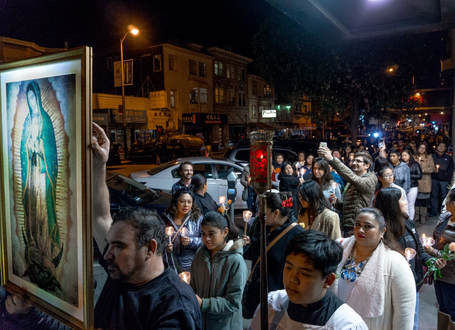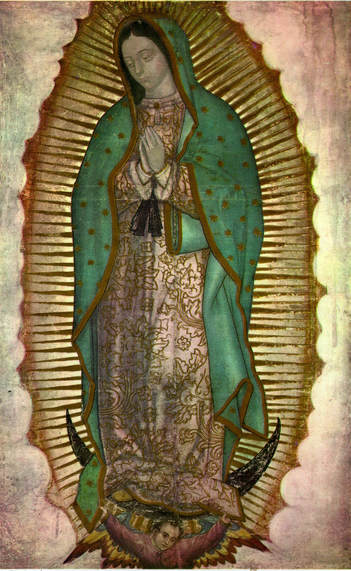 Some pics from our Guadalupe Mass and procession last week
Some pics from our Guadalupe Mass and procession last week “Gaudete Sunday” takes its name from the first word of its opening scripture verse, the introit from Philippians 4, which is also the Epistle for this Mass: Gaudete in Domino semper: iterum dico, gaudete. Dominus prope est. “Rejoice in the Lord always: again I say it, Rejoice!... the Lord is near.” From the perspective of a sinner facing judgement, the nearness of the Lord is fearful, as in the Dies irae sequence. But from the perspective of the sinner facing final redemption, his imminent arrival is joyful. We want to get on with the necessary judgement so we can get through Purgatory and on to Heaven. We want the Lord to come quickly, because the arrival of the Lord is always our supreme good. Thus the priest and the altar clothe themselves in rose vesture to indicate the joy of the Lord’s imminent arrival.
Joy is More than a Feeling
St. Paul does not ask but commands us to be joyful, in the imperative. He does not suggest; he requires that we radiate joy. Remember that birthday party when you were pouting and your mother said “You will be happy!” St. Paul can command joy because joy is not just a feeling. As they say in Retrouvaille, a program for troubled marriages, love is not a feeling; it is a decision. I will love you, even when I don’t love you! I will radiate joy, especially when I don’t feel joyful. Sound “inauthentic” or “fake?” It’s not. It’s simple fidelity. Contemporary culture, following the dictates of the sexual revolution, commands us to follow our feelings. Jesus commands us to overcome our feelings and to practice goodness even and especially when we don’t feel good. The good news is that we can choose to exercise joy even when things around us make us feel sad.
Joy is a virtue: it’s a habit we form by repeatedly choosing a good behavior.
Joy is a duty: God calls his disciples to radiate confident joy in his divine providence, the unshakable conviction that “all things work for the good for those who love God” (Romans 8:28). Joy is a net by which we catch souls, beginning with our own. A sad Christian is a bad Christian. We can lose our own soul by grumbling, by complaining, by falling into a pervasive negativity. When we grumble we throw God’s gifts back in his face. Complaining is a kind of blasphemy. And finally, joy is possible. God does not command the impossible. We all know people who have suffered terribly but remain serenely joyful.

How can I retain that joyful peace when so much is wrong within and without? St. Paul’s answer is clear: prayer. “Rejoice in the Lord always,” he says. “Have no anxiety at all, but by prayer and petition, with thanksgiving, make your requests known to God.” Like everyone else, I struggle with sadness, frustration and discouragement. Religion is a hard sell these days. Being a priest in a culture that marginalizes priests because it ignores God, and progressively despises religion, is not easy. You all struggle with discouragement with your own spouses, children, co-workers, and that worst of all enemies, yourself. Personally, what saves me is getting my old carcass out of bed and into the chapel every morning (after brushing my teeth, of course). Silent prayer before the Sacrament saves me.
The Star of the New Evangelization
The great image of Our Lady of Guadalupe to my left is still with us, as we are celebrating as it were the Octave of her feast (last Tuesday). She brought joy to an entire continent at the lowest point in American history. The most highly developed civilization on the American continent, the Aztec empire, was in its death throes. When she appeared to Juan Diego Cuatloatatzin in 1531, his civilization and the sacred beliefs of his ancestors were being destroyed by the Spaniards. She said to him, “Know for certain, my son, my littlest one, that I am the perfect and ever virgin holy Mary, mother of the true God, through whom all things live... I ardently desire that they build me here my sacred house, where I will show Him, I will exalt Him and make Him manifest. Where I will offer Him to all the people with all my love, my compassionate gaze, my help and my deliverance, Because I am truly your merciful mother, Yours and mother of all who live together in this land; now my son, my smallest one, you have heard my voice; go and do everything as best you can."
She appeared on the hill of the Aztec mother goddess Tonantzin, but she said she was the mother of God, not a god herself. She wanted to bring the one true God, which the Aztecs themselves called the true God, through whom all things live, to both Mexica and Spaniard, so that both peoples would know how much they are loved. You know the rest of the story, how Juan Diego opened his tilma to pour out roses for the bishop, roses the Lady had arranged in his tilma with her own hands. As the roses fell to the ground so did the bishop and his attendants, for this is what they saw. A woman with hands folded, praying in the European way, and her left leg bent in dance, praying in the Mexica way. So it was that the Lady brought the joy of prayer to both races, leading to their reconciliation and the mixing of these two peoples to form what is now the Mexican race.
Our Lady leads us in this dance before the Ark of God, for she is herself the Ark, within which rests the Divine Presence. The black maternity belt over her womb frames the only four-petal flower on her gown, the Aztec symbol of divinity. “Rejoice,” she says, for the “Lord is near,” just here in my womb, under my heart. “Let nothing disturb you;” she finally told Juan Diego, “am I not here who am your mother?”
For more information on Our Lady of Guadalupe, watch this video: Guadalupe: The Miracle and the Message


 RSS Feed
RSS Feed